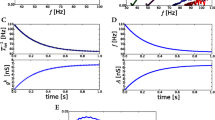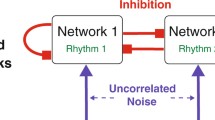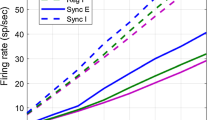Abstract
A model of a large population of excitable neurons with a globally slowly decaying inhibitory coupling is studied. A homogeneous network exhibits homogeneous solutions as well as cluster states. When the homogeneous and deterministic network is fully synchronized, stochastic noise cause the neurons to skip bursts. In addition to a synchronized periodic and asynchronous regimes, a heterogeneous network exhibits two novel regimes, one is partially synchronized and the other is partially asynchronized.
Access this chapter
Tax calculation will be finalised at checkout
Purchases are for personal use only
Preview
Unable to display preview. Download preview PDF.
Similar content being viewed by others
References
Steriade M., Jones E.G. and Llinás R.R. (1990), Thalamic oscillations and signaling, John Wiley & Sons, New-York.
Wang X.-J. and Rinzel J. (1993), “Spindle rhythmicity in the reticularis thalami nucleus: synchronization among mutually inhibitory neurons”, Neuroscience, 53, 899–904.
Golomb D. and Rinzel J., “Clustering in globally coupled neurons”, Physica D, in press.
Golomb D. and Rinzel J., “Dynamics of coupled inhibitory neurons with heterogeneity”, Phys. Rev. E, in press.
T.M. Fisher, M.A.L. Nicolellis and J.K. Chapin (1992), “Sensory and oscillatory properties of simultaneously recorded multi-single units in the thalamic reticular nucleus of the rat”, Neuroscience Abstr. 18 1392.
Author information
Authors and Affiliations
Editor information
Editors and Affiliations
Rights and permissions
Copyright information
© 1994 Springer Science+Business Media New York
About this chapter
Cite this chapter
Golomb, D., Rinzel, J. (1994). Synchronization among heterogeneous inhibitory RTN neurons globally coupled. In: Eeckman, F.H. (eds) Computation in Neurons and Neural Systems. Springer, Boston, MA. https://doi.org/10.1007/978-1-4615-2714-5_5
Download citation
DOI: https://doi.org/10.1007/978-1-4615-2714-5_5
Publisher Name: Springer, Boston, MA
Print ISBN: 978-1-4613-6169-5
Online ISBN: 978-1-4615-2714-5
eBook Packages: Springer Book Archive




